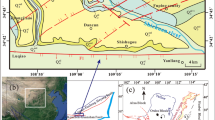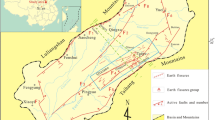Abstract
The Weihe Basin is part of the regionally extensive Fenwei Graben System, which is a major tectonic block impacted by active tectonics and human activities. There are 200 tectonic ground fissures in the Weihe Basin, some of which have resulted in loss of life and severe damage to infrastructure. The development characteristics and dynamic mechanisms of these fissures were investigated by surveying, mapping, and geological drilling. The fissures are distributed along the boundary faults between fault blocks with prominent regional, zoning, and directional characteristics. On the profiles of fissures, the tectonic ground fissures are connected with underlying faults and possess the characteristics of synsedimentary faults. The deeper the stratum is, the greater the fault displacement of the stratum is, and the greater the thickness of the strata on the hanging walls is than that on the heading walls. These fissures are driven by dynamic tectonic processes, including uplift of the upper mantle and extension of the crust, differential movement of the fault blocks, and fault activity. The extension and opening of fissures are accelerated by hydrodynamic progresses, including pumping and raining. This paper describes a study of the mechanisms of the fissures and provides guidance for prevention of disasters and reduction of disaster severity in this area.











Similar content being viewed by others
References
Ayalew L et al (2004) Ground cracks in Ethiopian Rift Valley: facts and uncertainties. Eng Geol 75(3–4):309–324
Brunori CA et al (2015) Land subsidence ground fissures and buried faults: InSAR monitoring of Ciudad Guzmán (Jalisco Mexico). Remote Sens 7(7):8610–8630
Budhu M (2011) Earth fissure formation from the mechanics of groundwater pumping. Int J Geomech 2011(11):1–11
Burbey TJ (2002) The influence of faults in basin-fill deposits on land subsidence Las Vegas Valley Nevada USA. Hydrogeol J 10(5):525–538
Carpenter MC (1993) Earth fissure movements associated with fluctuations in groundwater levels near the Picacho Mountains south-central Arizona 1980–1984. U.S. Geological Survey Professional, Reston, p 49 (Paper 497-H)
Carpenter MC (2015) Continuous monitoring of an earth fissure in Chino California USA—a management tool. Proc Int Assoc Hydrol Sci 372:291–296
Conway BD (2015) Land subsidence and earth fissures in south-central and southern Arizona USA. Hydrogeol J 24(3):649–655
Geng DY et al (2000) Ground fissure hazards in USA and China. Acta Seismol Sin 13(4):466–476
Group RLGR (2016) Ground failures on reclaimed land during the 2011 Tohoku earthquake: a case study in Urayasu City Japan. Quat Int 397:555–562
Haneberg WC et al (1995) Tilts strains and ground-water levels near an earth fissure in the Mimbres Basin New Mexico. Geol Soc Am Bull 107(3):316–326
He ZT et al (2017) Recent ground fissures in the Hetao basin Inner Mongolia China. Geomorphology 295:102–114
Holzer TL (1980) Faulting caused by ground water level declines San Joaquin Valley California. Water Resour Res 16(6):1065–1070
Holzer TL (1984) Ground failure induced by ground-water withdrawal from unconsolidated sediment. Rev Eng Geol 6:67–105
Howard KWF, Zhou WF (2019) Overview of ground fissure research in China. Environ Earth Sci 78:97
Keaton JR, Shlemon RJ (1991) The Fort Hancock Earth Fissure System Hudspeth County Texas: uncertainties and implications. Land Subsidence 200:281–290
Lee CF et al (1996) Evolution and origin of the ground fissures in Xi’an China. Eng Geol 43:45–55
Leonard RJ (1929) An Earth fissure in Southern Arizona. J Geol 37(8):765–774
Li M et al (2019) Research on development characteristics and failure mechanism of land subsidence and ground fissure in Xi’an monitored by using time-series SAR interferometry. Geomatics Nat Hazards Risk 10(1):699–718
Li YL et al (2000) Origin of ground fissures in the Shanxi Graben System Northern China. Eng Geol 55(4):267–275
Hernandez-Marin M, Burbey TJ (2010) Controls on initiation and propagation of pumping-induced earth fissures: insights from numerical simulations. Hydrogeol J 18(8):1773–1785
Okada Y (1985) Surface deformation due to shear and tensile faults in a half-space. Bull Seismol Soc Am 75(4):1135–1154
Pampeyan EH, Holzer TL, Clark MM (1988) Modern ground failure in the Garlock fault zone Fremont Valley California. Geol Soc Am Bull 100(5):677–691
Peltzer G, Tapponnier P (1988) Formation and evolution of strike-slip faults rifts and basins during the India-Asia Collision: an experimental approach. J Geophys Res Solid Earth 93(B12):15085–15117
Peng JB, Zhang J, Su SR, Mi FS (1992) Activity faults and geological hazards in Weihe Basin. Northwest University Press, Evanston, pp 16–44 (In Chinese)
Peng JB et al (2012) The hazard of Xi’an fissures. Science Press, Beijing, China (in Chinese)
Peng JB et al (2016a) Characteristics and mechanism of the Longyao ground fissure on North China Plain China. Eng Geol 214:136–146
Peng JB et al (2016b) Distribution and mechanism of the ground fissures in Wei River Basin, the origin of the Silk Road. Environ Earth Sci 75(8):718
Peng JB et al (2018a) Development characteristics and mechanisms of the Taigu-Qixian earth fissure group in the Taiyuan basin China. Environ Earth Sci 77(11):407
Peng JB et al (2018b) Geological factors for the formation of Xi’an ground fractures. J Earth Sci 29(2):468–478
Peng JB et al (2018c) Characteristics and mechanism of Sanyuan ground fissures in the Weihe Basin China. Eng Geol 247:48–57
Qiao JW et al (2018) Earth fissures in Qinglong Graben in Yuncheng Basin China. J Earth Syst Sci 127(1):10
Qu FF et al (2014) Land subsidence and ground fissures in Xi’an China 2005–2012 revealed by multi-band InSAR time-series analysis. Remote Sens Environ 155:366–376
Ramelli AR et al (2003) Ground cracks associated with the 1994 double spring flat earthquake west-central Nevada. Bull Seismol Soc Am 93(6):2762–2768
Robert CJ et al (1982) Differential compaction mechanism for earth fissures near Casa Grande Arizona. GSA Bull 93(10):998–1012
Sun P et al (2009) Weak tensile characteristics of loess in China — an important reason for ground fissures. Eng Geol 108(1–2):153–159
Wang FY et al (2019a) Mechanism of Fuping ground fissure in the Weihe Basin of northwest China: fault and rainfall. Environ Earth Sci 78(14):407
Wang FY et al (2019b) The origin and impact of the Shizhuang ground fissure Yingxian area Datong Basin China. Eng Geol 261:105283
Wang FY et al (2020a) Development characteristics and mechanisms of damage-causing urban ground fissures in Datong City China. Eng Geol 271:105605
Wang FY et al (2020b) A study of the symbiotic relationship between tectonic fissures and faults in the Fenwei Graben System China. Environ Earth Sci 79:212
Wang ZF et al (2018) Investigation into geohazards during urbanization process of Xi’an. China Nat Hazards 92(3):1937–1953
Williams FM et al (2004) Tensional fissures and crustal extension rates in the northern part of the Main Ethiopian Rift. J African Earth Sci 38(2):183–197
Xu JS et al (2015) The bending mechanism of Anping ground fissure in the Hebei Plain North China. Environ Earth Sci 74(9):6859–6870
Yang CS et al (2014) Monitoring land subsidence and fault deformation using the small baseline subset InSAR technique: a case study in the Datong Basin China. J Geodyn 75:34–40
Yang CS et al (2019) Ground deformation and fissure activity in Datong basin China 2007–2010 revealed by multi-track InSAR. Geomatics Nat Hazards Risk 10(1):465–482
Youssef AM et al (2014) Earth fissures in Wadi Najran Kingdom of Saudi Arabia. Nat Hazards 71(3):2013–2027
Zang MD et al (2014) Basement stretch and ground fissures formation in Linfen Basin. Appl Mech Mater 711:562–565
Zang MD et al (2019) Earth fissures developed within collapsible loess area caused by groundwater uplift in Weihe watershed northwestern China. J Asian Earth Sci 173:364–373
Zhang Q et al (2011) Analysis of present tectonic stress and regional ground fissure formation mechanism of the Weihe Basin. Surv Rev 43(322):382–389
Funding
This study was funded by the National Science Foundation of China (Nos. 41790441, 41877250, 41807234, and 41272284), the CMEC Technology Incubation Project (CMEC-KJFH-2018–02), the Fundamental Research Funds for the Central Universities, CHD (No. 300102269203), and the National Geological Survey of China (No. DD20160264).
Author information
Authors and Affiliations
Corresponding author
Rights and permissions
About this article
Cite this article
Wang, F., Peng, J., Lu, Q. et al. Development characteristics and dynamic mechanisms of tectonic ground fissures in Weihe Basin, China. Bull Eng Geol Environ 81, 12 (2022). https://doi.org/10.1007/s10064-021-02490-1
Received:
Accepted:
Published:
DOI: https://doi.org/10.1007/s10064-021-02490-1




